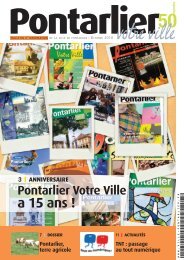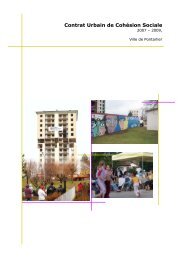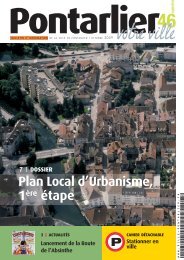1. la porte saint-pierre et les fortifications - Ville de Pontarlier
1. la porte saint-pierre et les fortifications - Ville de Pontarlier
1. la porte saint-pierre et les fortifications - Ville de Pontarlier
You also want an ePaper? Increase the reach of your titles
YUMPU automatically turns print PDFs into web optimized ePapers that Google loves.
PONTARLIER<br />
... Patrimoine Historique<br />
Quai du Doubs<br />
Rue Jeanne d’Arc<br />
1 - La Porte Saint-Pierre <strong>et</strong> <strong>les</strong> fortifi cations<br />
2 - Le Vieux Château <strong>et</strong> <strong>les</strong> fortifi cations<br />
3 - Le Camp <strong>de</strong>s Pareuses, le Doubs<br />
4 - Les Casernes Margu<strong>et</strong><br />
5 - Le Comte <strong>de</strong> Mirabeau<br />
Rue Mirabeau<br />
P<strong>la</strong>ce Ju<strong>les</strong> Pagnier<br />
Rue du Moulin Vieux<br />
Rue <strong>de</strong> <strong>la</strong> Répubique<br />
Rue <strong>de</strong> <strong>la</strong> Halle<br />
P<strong>la</strong>ce d’Arçon<br />
Rue du Vieux Chateau<br />
6 - L’Ancien Auditoire<br />
7 - L’Eglise <strong>et</strong> <strong>la</strong> P<strong>la</strong>ce Saint-Bénigne<br />
8 - Le Pa<strong>la</strong>is <strong>de</strong> Justice<br />
9 - La Gare<br />
10 - Le Collège Philippe Grenier<br />
Rue Tissot<br />
Rue Tissot<br />
Rue <strong>de</strong> La Gare Rue <strong>de</strong> La Gare<br />
Rue <strong>de</strong> <strong>la</strong> Répubique<br />
11 - La Chapelle <strong>de</strong>s Annoncia<strong>de</strong>s<br />
12 - L’Hôtel <strong>de</strong> <strong>Ville</strong><br />
13 - La P<strong>la</strong>ce d’Arçon<br />
14 - Le Musée Municipal<br />
15 - Le Théâtre Bernard Blier<br />
P<strong>la</strong>ce<br />
Villigen-Schwenningen
Imprimerie Simon<br />
Impression<br />
Collections du Musée Municipal <strong>de</strong> <strong>Pontarlier</strong> ;<br />
Archives municipa<strong>les</strong> <strong>de</strong> <strong>Pontarlier</strong> ;<br />
Philippe Ohrel ;<br />
Didier Jacquot.<br />
Crédits photographiques<br />
<strong>Ville</strong> <strong>de</strong> <strong>Pontarlier</strong><br />
Direction <strong>de</strong> <strong>la</strong> Communication <strong>et</strong> <strong>de</strong>s Re<strong>la</strong>tions Publiques<br />
Conception <strong>et</strong> rédaction<br />
Offi ce <strong>de</strong> Tourisme<br />
www.pontarlier.org<br />
<strong>Ville</strong> <strong>de</strong> <strong>Pontarlier</strong><br />
www.ville-pontarlier.fr<br />
PONTARLIER<br />
Circuit Patrimoine Historique<br />
Découvrez <strong>Pontarlier</strong> du XIII e siècle, temps <strong>de</strong>s fortifi cations,<br />
au XX e siècle. Les origines <strong>de</strong> <strong>la</strong> fondation <strong>de</strong> <strong>Pontarlier</strong> restent<br />
encore incertaines, toutefois <strong>de</strong>s traces d’occupation attestent<br />
d’une présence humaine sur le territoire dès le I er siècle. S’il<br />
émane aujourd’hui <strong>de</strong> <strong>la</strong> ville une atmosphère mo<strong>de</strong>rne, c’est<br />
qu’elle fut dévastée par <strong>de</strong> nombreux incendies au cours <strong>de</strong>s<br />
sièc<strong>les</strong> <strong>et</strong> reconstruite à maintes reprises. Au détour <strong>de</strong> ses rues<br />
<strong>et</strong> <strong>de</strong> ses bâtiments, explorez l’histoire oubliée <strong>de</strong> <strong>la</strong> capitale du<br />
Haut-Doubs.<br />
<strong>1.</strong> LA PORTE SAINT-PIERRE ET LES FORTIFICATIONS<br />
De part <strong>et</strong> d’autre <strong>de</strong> <strong>la</strong> Porte Saint-<br />
Pierre subsistent <strong>de</strong>s murs <strong>de</strong><br />
l’ancien rempart. La <strong>porte</strong> elle-même date du<br />
XVIII e siècle <strong>et</strong> a remp<strong>la</strong>cé l’ouvrage défensif<br />
<strong>de</strong> <strong>la</strong> Porte du Boulevard.<br />
On both si<strong>de</strong>s of the Porte Saint-<br />
Pierre – Saint P<strong>et</strong>er’s Gate –, there<br />
are still walls of the old fortifi cations. The<br />
gate itself dates back to the 18th century and<br />
rep<strong>la</strong>ced the Porte du Boulevard - the ‘Barbican Gate’ – fortifi cation.<br />
Auf bei<strong>de</strong>n Seiten das Stadttor Saint-Pierre sind die Mauern<br />
<strong>de</strong>r ehemaligen Besfestigungsmauer noch da. Das Stadttor<br />
selbst stammt aus <strong>de</strong>m 18. Jahrhun<strong>de</strong>rt und hat die Verteidigungsan<strong>la</strong>ge<br />
<strong>de</strong>m Boulevard Tor ers<strong>et</strong>zen.<br />
2. LE VIEUX CHÂTEAU ET LES FORTIFICATIONS<br />
Le château <strong>de</strong> <strong>Pontarlier</strong> fut détruit<br />
à plusieurs reprises au cours <strong>de</strong>s<br />
sièc<strong>les</strong>, notamment pendant <strong>la</strong> guerre entre<br />
<strong>les</strong> barons <strong>de</strong> Bourgogne (XIII e s.). Il abrita<br />
ensuite le collège <strong>de</strong>s Jésuites puis le couvent<br />
<strong>de</strong>s Bernardines.<br />
<strong>Pontarlier</strong>’s castle was <strong>de</strong>structed<br />
on numerous occasions across the<br />
centuries, in particu<strong>la</strong>r during the war b<strong>et</strong>ween<br />
the Burgundy noblemen (13th century). It <strong>la</strong>ter housed the Jesuits’<br />
school and then the Bernardines’ convent..<br />
Das Schloss von <strong>Pontarlier</strong> war mehrmals im Laufe <strong>de</strong>r<br />
Jahrhun<strong>de</strong>rte beson<strong>de</strong>rs während <strong>de</strong>s Krieges unter <strong>de</strong>n<br />
burgundischen Barone (13. JH) zerstört. Danach war in diesem Schloss<br />
die Jesuitenschule und dann das Kloster St Bernardin untergebracht.<br />
3. LE CAMP DES PAREUSES, LE DOUBS<br />
Depuis le Pont <strong>de</strong>s Chèvres,<br />
découvrez l’histoire du camp<br />
militaire <strong>de</strong>s Pareuses situé en contrefort<br />
(XIX e -XX e s.), ainsi que l’importance du Doubs<br />
à <strong>Pontarlier</strong>.<br />
From the Pont <strong>de</strong>s Chèvres – Goats’<br />
Bridge –, discover the history of<br />
the military camp of Les Pareuses up on the<br />
hill (19th-20th century) and the important rôle of the Doubs river in<br />
<strong>Pontarlier</strong>.<br />
Aus <strong>de</strong>m „Pont <strong>de</strong>s Chèvres“ (Brücke <strong>de</strong>r Ziegen), ent<strong>de</strong>cken<br />
Sie die Geschichte <strong>de</strong>s Truppen<strong>la</strong>gers <strong>de</strong>r Pareuses<br />
(19.-20. JH), sowie die Wichtigkeit <strong>de</strong>s Doubs in <strong>Pontarlier</strong>.<br />
4. LES CASERNES MARGUET<br />
Les casernes Margu<strong>et</strong> datent du XVIII e siècle. Jamais réservés<br />
au seul casernement militaire, <strong>les</strong> bâtiments ont connu <strong>de</strong>s<br />
utilisations diverses : hébergement <strong>de</strong>s haras royaux <strong>de</strong> Besançon, halle<br />
au blé...<br />
The Margu<strong>et</strong> barracks were built in the 18th century. They have<br />
always been used for various things besi<strong>de</strong>s military barracks:<br />
they housed the Besançon royal horse stud, the corn exchange...<br />
Die Margu<strong>et</strong> Kasernen stammt aus <strong>de</strong>m 18. Jahrhun<strong>de</strong>rt.<br />
Die Gebäu<strong>de</strong> haben unterschiedliche Benutzungen zusätzlich<br />
zu <strong>de</strong>r Militärbenutzung gehabt: Unterbringung von <strong>de</strong>n königlichen<br />
Gestüte, Halle von Weizen, usw.<br />
5. MIRABEAU<br />
Célèbre homme politique, Mirabeau<br />
avait une réputation sulfureuse. Ses<br />
aventures à <strong>Pontarlier</strong> avec Sophie <strong>de</strong> Monnier<br />
font encore l’obj<strong>et</strong> <strong>de</strong> savoureuses anecdotes.<br />
Mirabeau was a famous politician and<br />
had an infl ammatory reputation. His<br />
affair in <strong>Pontarlier</strong> with Sophie <strong>de</strong> Monnier is<br />
still the topic of spicy anecdotes.<br />
Mirabeau war ein berühmter und ein politischer Mann. Er hatte<br />
einen aufrühreirischen Ruf. In <strong>Pontarlier</strong> hatte er mit Sophie <strong>de</strong><br />
Monnier ein Liebesabenteuer das Gegenstan pikanter Anekdoten ist.<br />
6. L’ANCIEN AUDITOIRE<br />
Ce bâtiment occupa <strong>la</strong> fonction d’Auditoire, c’est-à-dire <strong>de</strong><br />
Pa<strong>la</strong>is <strong>de</strong> Justice, <strong>de</strong> 1743 à 1867. Ses décors sont typiques<br />
<strong>de</strong>s mo<strong>de</strong>s architectura<strong>les</strong> du XIX e siècle.<br />
This building was used as an Auditoire, that is to say a<br />
courthouse, from 1743 to 1867. It is typically <strong>de</strong>corated in the<br />
19th century fashion.<br />
Von 1743 bis 1867 diente dieses Gebäu<strong>de</strong> als Auditorium, das<br />
heisst als Justizpa<strong>la</strong>st. Seine Dekore sind für die Architektur<br />
<strong>de</strong>s 19. Jahrhun<strong>de</strong>rts typisch.<br />
7. L’EGLISE ET LA PLACE SAINT-BÉNIGNE<br />
L’église Saint-Bénigne com<strong>porte</strong><br />
<strong>de</strong>s vitraux du peintre Manessier<br />
(XX e siècle) <strong>et</strong> <strong>de</strong> remarquab<strong>les</strong> sculptures.<br />
La p<strong>la</strong>ce Saint-Bénigne est redressée par<br />
un portail monumental c<strong>la</strong>ssé Monument.<br />
Insi<strong>de</strong> the Saint-Bénigne church,<br />
discover stained-g<strong>la</strong>ss windows<br />
ma<strong>de</strong> by the painter Manessier (20th century)<br />
and markworthy sculptures. The Saint-Bénigne square is straightened<br />
out by a listed triumph gate.<br />
Die Kirche Saint-Bénigne besitzt Kirchenfenster <strong>de</strong>s<br />
Malers Manessiers (20. Jahrhun<strong>de</strong>rt) und bemerkenswerte<br />
Skulpturen. Am P<strong>la</strong>tz Saint-Bénigne fi nd<strong>et</strong> sich ein monumenta<strong>les</strong><br />
Portal, das unter Denkmalschutz steht.<br />
8. LE PALAIS DE JUSTICE<br />
Construit en 1865, le Pa<strong>la</strong>is <strong>de</strong> Justice <strong>de</strong> <strong>Pontarlier</strong> est<br />
d’époque Louis-Philippe. Son portique monumental confère<br />
à son architecture un style néo-c<strong>la</strong>ssique solennel.<br />
The courthouse of Louis-Philippe style was built in 1865. Its<br />
triumph gate gives its architecture a solemn neo-c<strong>la</strong>ssic style.<br />
Im Jahre 1865 war <strong>de</strong>r Justizpa<strong>la</strong>st <strong>Pontarlier</strong> – „Louis-<br />
Philippe“ Stil – gebaut. Seine monumentale Säulenhalle<br />
verheilt seine Architektur einen feierlichen neuk<strong>la</strong>ssischen Stil.<br />
9. LA GARE<br />
La gare <strong>de</strong> <strong>Pontarlier</strong> fut inaugurée<br />
peu avant l’ouverture <strong>de</strong> <strong>la</strong> ligne<br />
ferroviaire franco-suisse. Jusqu’au XX e siècle,<br />
c’était une gare internationale avec <strong>de</strong>s trains<br />
en partance vers <strong>la</strong> Suisse <strong>et</strong> l’Italie.<br />
The <strong>Pontarlier</strong> train station opened<br />
short before the French-Swiss train<br />
line was <strong>la</strong>unched. Until the 20h century, it<br />
was an international station with trains leaving for Switzer<strong>la</strong>nd and Italy.<br />
Der Bahnhof <strong>Pontarlier</strong> war kurz davor <strong>de</strong>r Öffnung <strong>de</strong>r<br />
französischen-schweizerischen Eisenbahnlinie. Bis <strong>de</strong>n<br />
20. JH war er ein internationaler Bahnhof mit Zügen nach <strong>de</strong>r Schweiz<br />
und Italien.<br />
10. LE COLLÈGE PHILIPPE GRENIER<br />
Construit en 1836, le collège fut occupé par <strong>les</strong> troupes<br />
françaises puis prussiennes pendant <strong>la</strong> guerre <strong>de</strong> 1870. Il<br />
abrita également le contrôle postal <strong>de</strong> 1914 à 1918. Depuis 1979, il<br />
<strong>porte</strong> le nom <strong>de</strong> collège Philippe Grenier, en hommage au mé<strong>de</strong>cin <strong>et</strong><br />
député pontissalien (1865-1944).<br />
The collège (secondary school) was built in 1836 and was<br />
occupied by French and then Prussian troops during the<br />
Franco-Prussian war. It also housed the post control from 1914 to 1918.<br />
It was named ‘Collège Philippe Grenier’ in 1979 after the <strong>Pontarlier</strong><br />
doctor and member of parliament (1965-1944).<br />
Im Jahre 1836 war das Gymnasium gebaut. Es was von<br />
<strong>de</strong>n französischen dann preussischen Truppen während <strong>de</strong>s<br />
Krieges 1870 best<strong>et</strong>zt. Von 1914 bis 1918 war in diesem Gebäu<strong>de</strong><br />
die Postkontrolle untergebracht. Seit 1979 ist es Gymnasium Philippe<br />
Grenier gennant, um <strong>de</strong>m Arzt und <strong>de</strong>m Abgordn<strong>et</strong>e aus <strong>Pontarlier</strong> zu<br />
würdigen.<br />
1<strong>1.</strong> LA CHAPELLE DES ANNONCIADES<br />
Les Annoncia<strong>de</strong>s étaient un <strong>de</strong>s<br />
six couvents installés à <strong>Pontarlier</strong><br />
jusqu’au XVIII e siècle. Il ne reste aujourd’hui<br />
que <strong>la</strong> chapelle <strong>et</strong> son portail c<strong>la</strong>ssé Monument<br />
Historique.<br />
The Sisters of the Annunciation were<br />
one of the six convents that existed<br />
in <strong>Pontarlier</strong> until the 18th century. Only the<br />
chapel and its listed gate remain today.<br />
Bis 18. JH war die Annoncia<strong>de</strong>s eines von sechs Klöstern in<br />
<strong>Pontarlier</strong> einges<strong>et</strong>zt. Es bleibt heute nur die Kapelle und sein<br />
Portal – unter Denkmalschutz gestellt – übrig.<br />
12. L’HÔTEL DE VILLE<br />
L’Hôtel <strong>de</strong> <strong>Ville</strong> fut construit <strong>de</strong> 1832 à 1838 à l’emp<strong>la</strong>cement<br />
<strong>de</strong> <strong>la</strong> première Maison <strong>de</strong> <strong>Ville</strong> <strong>et</strong> du couvent <strong>de</strong>s Jésuites.<br />
Son architecture sobre <strong>et</strong> puissante est typique du Haut-Doubs du XIX e<br />
siècle.<br />
The town hall was built b<strong>et</strong>ween 1832 and 1838 at the p<strong>la</strong>ce<br />
where the fi rst town house and of the Jesuits convent stood.<br />
Its sober and powerful architecture is typical of the 19th century Haut-<br />
Doubs.<br />
Von 1832 bis 1838 war das Rathaus an <strong>de</strong>r Stelle vom ersten<br />
Rathaus und vom Kloster <strong>de</strong>r Jesuiten gebaut. Die nüchterne<br />
und gewaltige Architektur ist für das Haut-Doubs <strong>de</strong>s 19. Jahrhun<strong>de</strong>rts<br />
typisch.<br />
13. LA PLACE D’ARÇON<br />
Autrefois appelée p<strong>la</strong>ce Saint-Antoine,<br />
<strong>la</strong> p<strong>la</strong>ce d’Arçon fut rebaptisée<br />
en 1836 du nom <strong>de</strong> l’ingénieur qui réalisa<br />
<strong>les</strong> p<strong>la</strong>ns <strong>de</strong> <strong>la</strong> <strong>porte</strong> Saint-Pierre. Elle est<br />
aujourd’hui le cœur <strong>de</strong> <strong>la</strong> ville.<br />
Formerly called P<strong>la</strong>ce Saint-Antoine<br />
– Saint-Anthony’s Square –, the<br />
P<strong>la</strong>ce d’Arçon was renamed in 1836 after the<br />
name of the engineer who drew the p<strong>la</strong>ns for<br />
the Porte Saint-Pierre – Saint P<strong>et</strong>er’s Gate. Today, it is the heart of the<br />
town.<br />
Früher Saint Antoine P<strong>la</strong>tz gennant, war im Jahre 1836 <strong>de</strong>r<br />
Arçon P<strong>la</strong>tz namens <strong>de</strong>r Ingenieur, <strong>de</strong>r die Pläne <strong>de</strong>s Stadttor<br />
Saint Pierre ausgearbeit<strong>et</strong> hat, umbennant. Heute ist er das Herz <strong>de</strong>r<br />
Stadt.<br />
14. LE MUSÉE<br />
Le bâtiment qui accueille le Musée<br />
est sans doute un <strong>de</strong>s plus anciens<br />
<strong>de</strong> <strong>la</strong> ville. Outre <strong>les</strong> collections qu’il abrite,<br />
notamment sur l’absinthe, il a conservé <strong>de</strong>s<br />
éléments d’architecture uniques.<br />
The museum is housed in probably<br />
one of the ol<strong>de</strong>st buildings in town.<br />
It has fi ne collections, in particu<strong>la</strong>r about<br />
absinthe, and has r<strong>et</strong>ained unique architectural<br />
elements.<br />
Dieses Gebäu<strong>de</strong> ist zweifellos ein, <strong>de</strong>r Stadt ältest. Außer <strong>de</strong>n<br />
Sammlungen, die es, beson<strong>de</strong>rs über Absinth, untergebracht<br />
sind, hat es einzige Elemente von Architekturen aufbewahrt.<br />
15. LE THÉÂTRE BERNARD BLIER<br />
Inauguré en 1900 au-<strong>de</strong>ssus <strong>de</strong> <strong>la</strong><br />
halle au blé, le théâtre fut construit<br />
à <strong>la</strong> <strong>de</strong>man<strong>de</strong> <strong>de</strong>s autorités militaires pour<br />
proposer d’autres distractions aux troupes<br />
stationnées à <strong>Pontarlier</strong>, que <strong>la</strong> fréquentation<br />
<strong>de</strong>s bistrots <strong>de</strong> <strong>la</strong> ville.<br />
The theatre opened in 1900 above<br />
the corn mark<strong>et</strong>. It was built at the<br />
military authorities’ request so that soldiers in<br />
<strong>Pontarlier</strong> would have other pastimes than going to bars in town.<br />
Im Jahre 1900 war das Theater über <strong>de</strong>r Halle von Weizen<br />
eingeweiht. Die Militärbehör<strong>de</strong>n wollten, dass das Theater<br />
gebaut ist, um an<strong>de</strong>re Zeitvertreibe vorzusch<strong>la</strong>gen.

















